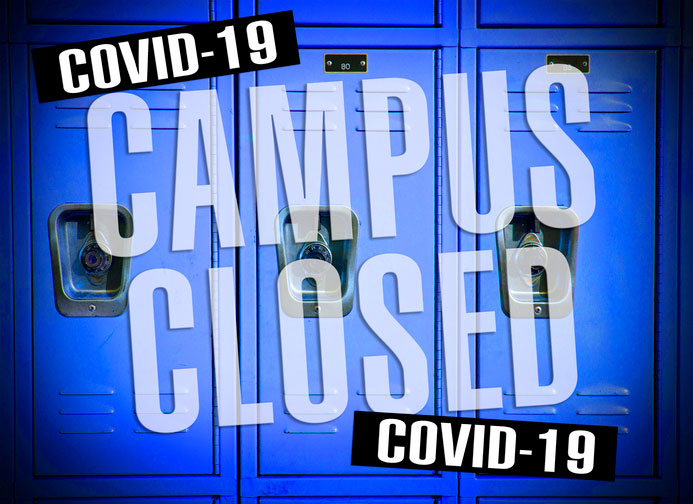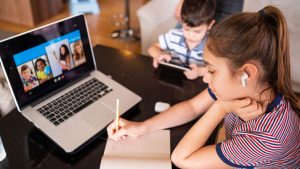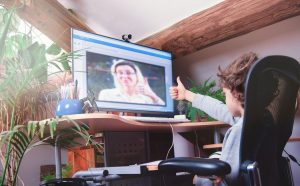3 + 3 = COVID19: Solutions for Remote Learning Under Stay-at-Home Orders
4/30/2020

We need to look ahead to August….NOW!
Though many of us are optimistic that students and staff will be back in the building in the fall, I worry we are not being proactive enough with our students and staff. We know what the virus can do and how it can devastate a family and disrupt a school building, yet what are we doing about it? What can we do now to be ready?
Having a great back up plan when we can't go back to school exemplifies the foresightedness and leadership we all need NOW!
I believe there are things we can be doing right now with our students and staff so we are ready to jump to an alternative plan, if the worst case scenario occurs. Most of us in education were stunned and caught off guard when state leadership shut down our schools. We were not ready for the ramifications of remote learning, and none of us knew what it truly entailed.
In my school we were fortunate enough to be asking questions about remote learning earlier after two school closures this year: one for a bomb threat, and the other for a brutal crime scene located on school property.
We started asking questions about our aggregate (required) hours, possibly adding a day of instruction, and finally deciding on the decision to add five minutes to every school day for the remainder of the year. This proposal was approved by the State Superintendent of Public Instruction in order to cover our missed instructional time. We also asked, what if students had the opportunity to make this time up at home, remotely. We sarcastically groaned at the time, because we knew this would be virtually impossible since so many of our families do not have adequate wireless connectivity or a device.
We all believe a device and wireless access should be part of all children's education! In fact, we believe teachers should not be left out either - many of our staff do not have a reliable internet connection or even an internet capable device at home!
We all agree the best instruction happens on campus and face to face with teachers. Teachers can adjust the instruction on the fly, engage students immediately, and support a student's emotional and social needs.
When a school closure occurs for a virus or any other reason, I believe we must create the best virtual learning environment for our children. I believe remote learning should be both synchronous and asynchronous, meaning some learning happens all together at the same time, and some learning occurs individually. The power of asynchronous learning is in the fact that students can access the learning material on their own time frame, and go back to it repeatedly.
Personally, getting my master's degree online was probably the best thing I could have done to support me now as an online leader. During my course work I met with teammates for projects, corresponded and replied to thousands of email threads, and read an enormous amount of material. My favorite learning experience was working with my team to conduct live court cases based on case studies. This mix of synchronous and asynchronous learning was all new to me, but it was exactly what I needed. I had teammates and my professors to hold me accountable, and then I was able to review content repeatedly until I understood it - all on my own time frame. As a slow reader, being able to read something multiple times is a helpful strategy. Remote learning isn't for everyone, in fact many people would rather learn in person with a teacher. As educators though, we need to set our students up for remote learning so they can be successful. We may not always have the choice to be on campus!
It is time to change the face of education. We must be proactive now so we are not caught off guard like we were this past spring.
Here's some ideas to help both students and staff prepare for the coming school year:
1 - Students need a device.

I am a firm believer in public education. We all would like our students to attend school and receive a free and appropriate public education (FAPE). What COVID19 has highlighted is the drastic disparity between the "haves" and the "have-nots." The "haves" have devices and internet connectivity at home, while many of our "have-nots" do not have a device nor do they have reliable access to the internet. We must be proactive and level the playing field.
I believe state and national governments should be paying for an appropriate education, which includes an internet-enabled device that allows them to access curriculum, communicate with teachers, and to get online for leaning and research. I understand that technology should enhance education and not be the end all for instruction.
When working remotely, equity becomes an issue for these families that do not have technology. We can continue to create paper packets for students to complete, but without the internet, students are unable to access the rest of their class experiences which could include instructional audio and videos created by teachers, and more.
Teaching students to take care of technology is something we already do in our schools. We can take that to the next level by teaching our families to take care of their devices. As cheap as devices have become, mass procurement for all students is something that should be the responsibility of our national and state governments.
2 - Students need internet connectivity.

I believe schools should be providing internet access for all students. This should be done through state and national funding. I have stated previously in my posts that we can build elaborate roads across our country, so why can't we build extensive internet wireless networks. The possibilities for learning would be limitless if all communities had free access to the internet.
I believe it would be archaic to hardwire student homes with cable or DSL hardline service. It makes much more sense to build "super-hotspots" for communities so that everyone can access the internet via Wi-Fi. Yes, this leads to filtering and accessibility issues, but what better time to regulate what students can access than when offering free public Wi-Fi to families, and rolling it out with reasonable restrictions if they want to access it. In this manner, I believe we can get some control back with regard to what our students can and cannot access online.
No matter where a student might be located, especially our most transient, they could access the internet and complete remote learning anywhere. Even when visiting family in a different community they would be able to access the same learning material as they would at home.
If we are unable to build and provide wireless communities, then the next best idea I believe is providing hotspots for individual families. The beauty of wireless hub devices that access wireless internet service like LTE and the soon-to-be-available 5G is that they are portable. With it, a student can access the internet almost anywhere in the United States. Of course this brings about even more penitential sticking points when it comes to regulating what students access, but the payoff is big enough to make that challenge worth dealing with.
3 - Students need practice!

Students need practice, procedures, and guidelines to be successful at remote learning. We closed schools and tried to give parents and teachers as much support and resources as possible. Let's be honest, we were not ready as educators, nor were our families, and more so, our students were not ready to take on remote learning. Though our resilient students, families, and teaches have persevered, we can do better!
Remote learning requires students and families to be self-motivated, self -directed, and have a sense of agency. As educators, we know how hard it is to motivate and engage our students in the classrooms. Putting our students in their home environments where they have access to video games, television, and other distracting vices and devices makes learning there unpredictable.
At school we need to continue working on agency with students in the classrooms, which is the ability for students to be self-directed in their own learning. We can test them and motivate them to complete tasks at home, but the fact remains, many schools have already loosened up on homework requirements over the past years, which doesn't make it any easier to place demands on what they should be doing at home now. We know students are going home to sports, chores, supporting their families, and in some cases persisting through an abusive homelife where getting work done is improbable. We understand the inequities that are pervasive in our community and we too have loosened our homework requirements in my school.
As educators, we know who will complete their homework, and we know which students will struggle. During COVID19, we are moving our primary mode of teaching to something that is more in line with our lowered expectations for homework. Under the current school-at-home model are still having to ask students to complete more work at home than we ever have in the past, but we are also giving lots of grace when it comes to due dates and completing assignments.
Let's build students up with a strong sense of responsibility and agency. We can do so by continuing to teach procedures, establish clear guidelines, and practicing remote learning.
When we do go back, let's start planning on teaching some days on campus and mixing that with some days off campus with remote learning. I believe practicing remote learning when it is not required is practical and smart in order to reduce stress when we need to transition to remote learning. Yes, face to face is the best instructional plan, but let's take time to build our student's remote learning skills too.
1 - Teacher's Need Technology

Teachers need the proper technology to teach effectively from home. In my school, most of the teachers are using their own devices to provide remote learning experiences for their students. We also expect them to sue their own internet service.
If students are provided remote learning experiences, teachers then need a device, stable internet access, and high quality hardware and software with video production capabilities. Currently, most of the teachers in my school are using their smart phones and Chromebooks to create short video lessons for students. The problem is that these videos have volume and video quality problems at times for students, but those are things that a good hardware upgrade and some decent video production software would fix.
Zoom, Google Meet, and Web-Ex have all been life-savers for teachers. Making sure students know and understand how to access these live video applications is feasible, but with this sense of ease comes the ability for others to take advantage… Zoombombing!
People are finding ways to break into these meetings, making students and teachers susceptible to unwanted interactions. Making sure students and teachers have a private and fully secure application is vital to successful positive learning interactions on a live application.
Using applications such as Seesaw, teachers can connect with students and families in a safe manner where student information is guarded. This web 2.0 application can support remote learning with a level of interactivity that no old fashioned homework packet could match. With the free version of Seesaw, there are certain restrictions on how long videos can be. Teachers obviously need subscriptions to some of these powerful applications for learning.
2 - Teacher's Need Professional Development

Teachers have been learning new technology on the fly during school closures. In my school, only a few teachers had experimented with some Web 2.0 applications. Many teachers found themselves scrambling to learn how to use these tools and are now hungry for professional development that would help them hone these kinds of skills.
We can provide professional development right now for teachers so they can be ready for remote learning next fall, getting them up to speed on all the applications and providing the necessary technical support along the way. This professional development will also need to address how teachers will increase learning opportunities through differentiating curriculum, instruction, and assessment, all while teaching remotely.
Most are not shying away from this technology hurricane during closure, and many teachers are experimenting with other tools and methods they come across. Leadership should be giving teachers time, resources, and the license to take a risk with new technology. Differentiating professional development becomes pivotal in pushing teachers to new levels. Sharing ideas during these professional development offerings will also push your entire school to new levels.
3 - Teacher Collaboration

Teaches need time to collaborate with one another to tap into extensive resources that other colleagues, service providers, parents, and community organizations can offer. Connecting teachers with the correct people to help meet the needs of the students is crucial.
While this happens continuously while students and staff are on campus, doing it remotely can be difficult. Whether a teacher is communicating with a mental health therapist for a student, or getting food to a family, teachers need to advocate and meet their student's basic needs before they can learn.
Our colleagues are all at different levels of personal learning. I believe we need to tap our own colleagues' expertise in order to push ourselves to meet student's learning needs. Meetings and professional learning time should be scheduled weekly when teachers are on campus. This needs to occur even more frequently during periods where remote learning is necessary. Teachers troubleshoot and problem solve continuously for parents, other staff members, and especially students. Sharing ideas with the teammates that make up your professional learning network can support your success as a teacher.
Teachers also need to be in touch with other community services that are available to support their students. This could be food pantries, doctors, clothing suppliers, dentists, or therapists. Students need access to these supports, whether they're learning on-campus or at home, and they need to be easily accessible.

Let's get working on meeting these challenges for both students and teachers. We only have a little over three months to put much of this in place. We can be proactive and make a difference!
- Learning How to Say No and Set Boundaries with Parents - November 21, 2022
- If You Had Only One Behavior Strategy to Use in Your Classroom, What Would It Be? - September 26, 2022
- Live Your Code: 7 Strategies That Will Help You Be the Most Effective Educator You Can Be - August 15, 2022











